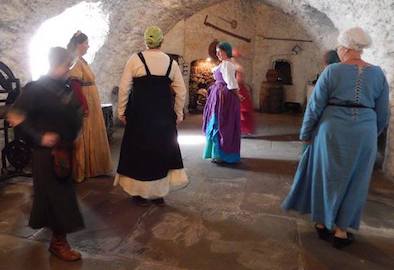
Bardic Performances
We are fortunate to have many talented musicians and singers, storytellers, poets and actors who will entertain at most of our events. We have choral perfomances at formal occasions, we sing drinking songs full of life and good cheer after great feasts, instrumental music wafts through the evening air at campsites. Stories are told at the fireside, plays are performed under the open sky at Raglan fair, dancers wheel and step and turn in Great halls. We have magicians and jugglers and puppeteers, all manner of performing arts from the Middle Ages can be found in the Society.
Dancing
Dance is a very popular, and based on research into the actual dance steps of the day, some are simple and easy to get started with, some are intricate and take a while to master. Dancing is taught at a some local events and demos are it’s often an activity for a Friday evening at a weekend event. There are some events that focus on dancing as a substantial theme.
Principality Dances
To help with introducing people into SCA dancing within Insulae Draconis, the Principality has chosen five dances so that people can have common number of dances to start from. This means when someone shows up to a ball they can dance without having to know hundreds of different dances. The Princess may, in the course of her reign, choose a signature dance for its duration.
- Double Bransle Suite (Double Bransle, Single Bransle, Burgundian and Gay)
- Ly Bens Dysonis (also works as token Gresley)
- Petit Vriens
- Idiots Pavane (Belle Qui tien) aka Knowne Worlde Pavane
Previous Princesses’ (and Vicerines’) choices for dances were:
- Viscountess Caitriona of the Ravens: The Maltese Brawl
- Viscountess Eularia Trewe: Gathering Peascods
- Mistress Ursula Sturlasdatter: Black Nag
- Mistress Æringunnr Yrsudóttir: Rufty Tufty
- Viscountess Susannah of York: Offical Bransle (toss the Dutchess)
- Dame Genevieve la flechiere: Amoroso, by Ebreo